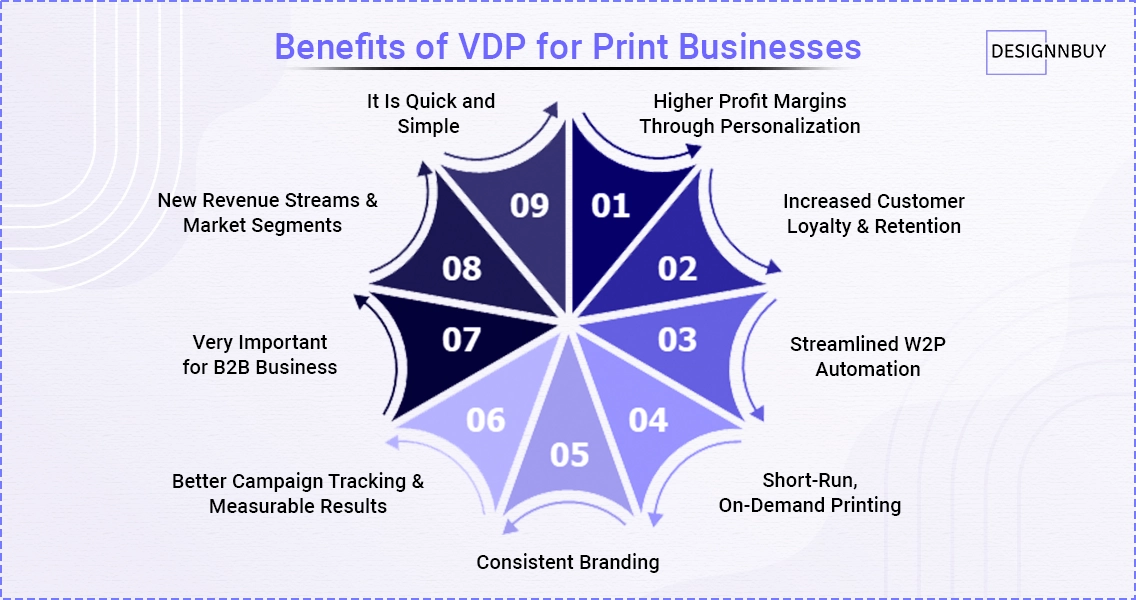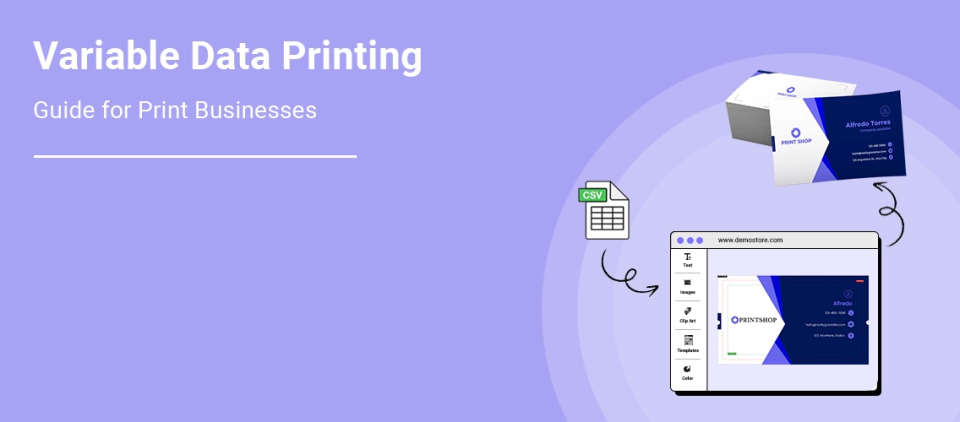As a print business owner, you might have observed a shift that client today are not just asking for prints. They want personalized prints.
From custom packaging to targeted marketing materials, personalization has moved from “nice-to-have” to a must-have in 2025.
And that’s exactly where Variable Data Printing (VDP) comes into play.
If you’re running a print business, who is offering online printing services this guide is for you. You’ll get to know about what VDP is and its types, how it works, and the benefits of offering Variable Data Printing.
So let’s get started!
Table of Contents
What Is Variable Data Printing?
Variable Data Printing (VDP) is a digital printing technique that allows you to change elements such as text, images, graphics, and even layouts from one printed piece to the next, without stopping or slowing down the printing process.
Imagine sending out 1,000 postcards, each with a different name, photo, and offer tailored to the recipient, all printed in one seamless run. That’s the power of VDP.
Static printing means every piece is identical. Variable printing means each piece can be unique, based on data.
This kind of personalization used to be complex and costly. But with digital presses and modern software, it’s now accessible even to small and mid-sized print businesses. Whether it’s personalized labels, direct mailers, event invitations, or packaging, VDP has become a game-changer.
How Does Variable Data Printing Work?

1. Template Creation
A static design template is created directly within a Web-to-Print editor.
This template includes placeholder fields (e.g., for name, address, image, QR code) that will later be populated with variable data.
2. Data Collection & Integration
A data source is uploaded or connected, this could be a CSV file, a database, a CRM system, or even form inputs from an online storefront.
Each row in the data file represents one version of the final print output, containing all the fields that need to be personalized.
3. Dynamic Data Mapping
The system maps the fields from the database to the placeholder fields in the design. For example:
{{FirstName}}becomes “John”{{City}}becomes “New York”{{PromoCode}}becomes “SAVE20”
This mapping can also include logic (e.g., conditional content or images based on customer segment).
4. Pre-Flight & Preview
Most Web-to-Print platforms offer a real-time preview so users can verify how the final print will look with actual data.
The system runs pre-flight checks to ensure fonts, image resolution, bleed, and layout are correct.
5. RIP (Raster Image Processing)
Once approved, the system sends the data-rich files to a digital printer. During RIP, each personalized version is interpreted and rasterized to be print-ready, each one unique, but printed in sequence without stopping the press.
6. Digital Printing Execution
A high-speed digital press (e.g., from HP Indigo, Xerox, or Canon) prints each customized piece in-line. Because no physical plates are needed, VDP is perfect for short runs and just-in-time production.
7. Post-Processing & Delivery
The printed materials are cut, folded, finished, and packed, often with integrated tracking systems. If part of a mailing campaign, the output can go straight into fulfillment for delivery.
Types of Variable Data Printing
VDP comes in different levels depending on complexity and the type of personalization involved:
- Basic VDP: This involves simple text changes like the recipient’s name or address. It’s ideal for direct mail campaigns.
- Intermediate VDP: This adds customized images, QR codes, or offers based on customer data.
- Advanced VDP: This level uses multiple data points to dynamically change layouts, product recommendations, or messages depending on customer behavior, location, or order history.
For example, an online store might send out flyers with personalized product suggestions based on browsing or purchase data. Or a cosmetics brand might send a promotional card with a model that reflects the customer’s demographic.
Benefits of VDP for Print Businesses

Variable Data Printing (VDP) allows print businesses to deliver high-value, personalized print products with speed and accuracy, opening the door to new revenue streams, stronger client relationships, and increased operational efficiency.
Here are the key benefits of adopting VDP for your print business:
1. Higher Profit Margins Through Personalization
VDP enables highly targeted, customized print products that command premium pricing.
Clients are willing to pay more for personalized materials that drive better results, such as direct mail with individualized messaging or event collateral tailored to each attendee.
✅ Upsell opportunity: From static brochures to personalized marketing kits
✅ Value-added service: Clients view you as a marketing partner, not just a printer
2. Increased Customer Loyalty and Retention
By offering VDP, you empower your clients to run more effective campaigns. When their personalized materials outperform generic ones, they’re more likely to return for future jobs, creating long-term, recurring business relationships.
✅ Proven ROI for clients = higher lifetime value for you
✅ Become indispensable to clients’ campaign strategies
3. Streamlined Web-to-Print Automation
When integrated into a Web-to-Print (W2P) platform, VDP allows customers to personalize and order print products online, without manual intervention. This reduces errors, accelerates turnaround, and enables 24/7 order intake.
✅ Fewer touchpoints, faster workflow
✅ Scale personalized jobs without scaling your workforce
▶️ Add VDP to your Print Business. Book a Free demo now!
4. Efficient Short-Run, On-Demand Printing
VDP is powered by digital printing, making it ideal for short runs and one-to-one marketing. You can fulfill micro-campaigns or test runs profitably, without the setup time and waste associated with offset printing.
✅ Reduced waste = better margins
✅ Serve niche campaigns with agility
5. Consistent Branding
VDP ensures every piece of printed material maintains your client’s brand identity, even when personalizing for different customers, branches, or departments. This consistency builds trust and brand recall.
6. Better Campaign Tracking & Measurable Results
When paired with dynamic QR codes or personalized URLs (PURLs), VDP campaigns offer trackable engagement metrics, proving print’s effectiveness in the digital age. This data helps your clients improve ROI, and helps you sell future campaigns.
✅ Print becomes measurable, like digital marketing
✅ Stronger case studies = more sales enablement
7. Very Important for B2B Business
VDP allows print businesses to take on large-scale personalized print jobs for corporate clients like, custom reports, labels, ID cards, packaging, and employee communications.
This opens doors to more lucrative B2B partnerships.
8. New Revenue Streams & Market Segments
VDP opens doors to new industries and verticals such as real estate, education, healthcare, and eCommerce, where personalization is critical. You’re not just printing materials; you’re enabling customized experiences.
✅ Attract clients who need smart print: event planners, marketers, educators, etc.
✅ Offer products like personalized packaging, direct mail, ID cards, and loyalty kits
9. It Is Quick and Simple
For businesses or clients who want light personalization, like adding a name, location, or small design tweak, VDP offers a fast turnaround time without compromising on quality.
Real-World Use Cases
Let’s look at practical examples of how VDP is used across industries:
- Corporate & B2B Clients: Customized reports, Employee ID cards, Training manuals, Packaging, and Internal communication kits.
- Franchise Businesses: Personalize flyers, signage, packaging, and direct mail with store-specific info while maintaining brand standards across all locations.
- Retail & E-commerce: Personalized thank-you cards, discount flyers, and loyalty program materials tailored to each shopper.
- Events & Conferences: Badges and invitations with personal schedules, names, and QR codes.
- Education: Certificates, student ID cards, or exam materials with unique student data.
- Healthcare: Patient appointment reminders, personalized instructions, or wellness plans.
- Packaging: Brands use VDP to print custom packaging for influencers, customers, or seasonal promotions.
- Hospitality: Customized welcome kits for guests with itineraries, names, and room numbers.
Challenges in Variable Data Printing and How to Solve Them?
❌ Poor Data Quality
Inaccurate or incomplete data can ruin a campaign. Make sure your data is clean, verified, and relevant. Encourage clients to maintain good data hygiene.
❌ Complex Templates
Building VDP templates can be tricky. Use intuitive software and hire designers with experience in data-driven print layouts.
❌ Initial Setup Cost
Software, training, and equipment have costs. But these are quickly offset by the added value and revenue from offering VDP services.
❌ Client Education
Not all clients understand the potential of VDP. Educate them with demos, sample campaigns, and measurable success metrics.
How to Start Offering VDP in Your Print Business
Variable Data Printing (VDP) unlocks massive potential for print businesses by delivering personalized, high-margin print products at scale.
If you’re looking to add VDP to your service portfolio, here’s a step-by-step guide to get started, efficiently and strategically.
1. Understand the Market Demand
Before investing in tools or equipment, assess your target customers:
Are they running direct mail campaigns?
Do they need personalized event materials, packaging, or certificates?
Are they agencies or brands looking for print-driven personalization?
✅ Pro Tip: Real estate, education, retail, healthcare, and non-profits are strong VDP clients.
2. Invest in the Right Digital Printing Equipment
VDP requires digital presses capable of printing customized output without stopping or resetting. Popular options include:
- HP Indigo
- Xerox Iridesse
- Canon imagePRESS
- Konica Minolta AccurioPress
Choose equipment based on:
- Your current and expected volume
- Print formats (e.g. postcards, brochures, labels)
- Color and finishing capabilities
3. Choose a VDP-Capable Web-to-Print Platform
Integrate your storefront with a Web-to-Print solution that supports VDP. Key features to look for:
- Dynamic template editing (text, images, QR codes)
- Data upload support (CSV, Excel, APIs)
- Live previews for end users
- Automation workflows for proofing and print file generation
4. Create Dynamic Templates for Popular Products
Start with high-demand products like:
- Business cards with employee data
- Personalized postcards and mailers
- Event badges and certificates
- Custom packaging or labels
Use a web-to-print design software to build smart templates with variable fields (e.g., name, city, product image, QR code).
5. Set Up Data Management Processes
Enable your clients to upload their variable data securely:
- CSV or Excel files
- CRM/database integrations (via API)
- Online form entries from your storefront
Ensure you have data validation rules in place to avoid errors before print.
6. Educate Your Sales Team & Clients
Offer training and sales collateral that explains:
- What VDP is?
- The benefits of personalization
- Use cases across industries
- ROI from past campaigns (include case studies)
✅ Tip: Create demo kits and sample campaigns to show potential.
7. Start Small, Then Scale
Begin with a few pilot projects. Refine your workflow before taking on larger or more complex jobs. Use early wins to build credibility, get testimonials, and grow word-of-mouth.
8. Offer Campaign Support Services (Optional but Powerful)
To truly differentiate, offer clients more than print:
- Design assistance for VDP campaigns
- Data cleanup & segmentation
- Campaign tracking tools (QR codes, URLs)
- Fulfillment & mailing services
This positions you not just as a print vendor, but a complete marketing solutions provider.
Final Thoughts
Variable Data Printing is transforming the print industry. No longer a high-end option for large companies, it’s now a must-have capability for printers of all sizes who want to meet modern customer expectations.
Whether you’re looking to add more value to your services, improve your sustainability, or help clients stand out, VDP offers the tools and flexibility to do it.
If you’re looking to offer VDP service at scale, then go for DesignNBuy‘s web to print solution. It is easy to implement and comes with useful features like online customization, automated workflows, and seamless integration.
Ready to add VDP to Your Services?
DesignNBuy’s Web-to-Print solution makes it easy to implement.




